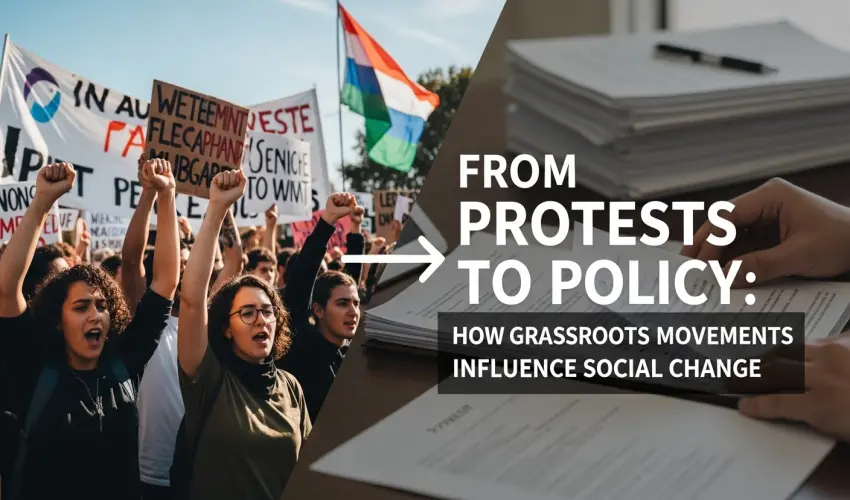From Protests to Policy: How Grassroots Movements Influence Social Change
Discover how grassroots movements turn street protests into policy. Explore the journey from activism to advocacy, with real-world examples of how community-driven efforts create lasting social change.
Key Takeaways
-
Grassroots movements are community-driven efforts demanding social or political change.
-
Protests are crucial for raising public awareness and initiating urgent conversations.
-
Successful movements transition from activism to targeted advocacy for policy reform.
-
Storytelling, digital tools, and organized tactics are essential for grassroots success.
-
Real-world examples include the Civil Rights Movement, Arab Spring, and Fridays for Future.
-
Sustained grassroots pressure often leads to new laws and systemic reforms.
-
Youth, marginalized groups, and local communities are key drivers of these movements.
-
The work continues after protests through voting, lobbying, and community organizing.
-
Achieving policy change requires a long-term commitment beyond initial activism.
Introduction: The Power of the People
Change often begins not with a law but with a voice, a protest, a poster, a public outcry. Grassroots movements have long been the spark behind major social transformations, proving that power doesn’t only reside in parliaments or palaces—it lives in the people.
From civil rights to climate action, grassroots protests have disrupted the status quo and paved the way for policy change. But how do these movements evolve from chants in the street to concrete legal reform? This article explores the journey from protest to policy and how ordinary citizens continue to reshape societies from the ground up.
What Are Grassroots Movements?
Grassroots movements are community-led initiatives that emerge organically from the concerns of the people, not from governments or institutions. They often begin with protests, awareness campaigns, or local organizing and aim to:
-
Challenge social injustices.
-
Demand accountability from institutions.
-
Inspire cultural and political shifts.
-
Influence legislation and reform.
These efforts rely on collective action, bringing together those most affected by an issue to advocate for their own rights and solutions.
The Power of Protest: From the Streets to the Spotlight
Protests are often the first public expression of a grassroots movement. While sometimes seen as disruptive, history proves they play a crucial role in catalyzing change by:
-
Raising awareness on underrepresented or ignored issues.
-
Attracting media attention and public scrutiny.
-
Mobilizing communities through shared emotion and purpose.
-
Forcing authorities to respond to public demands.
Historic examples like the U.S. Civil Rights Movement, the Arab Spring, and the Black Lives Matter movement all used protests to command global attention and initiate conversations that could no longer be ignored.
From Activism to Advocacy: The Strategic Pivot
After a protest gains momentum, successful movements pivot from broad activism to targeted advocacy, focusing on specific, actionable demands. This crucial phase includes:
-
Drafting proposed policies or amendments.
-
Engaging directly with lawmakers and local governments.
-
Organizing petitions and voter registration drives.
-
Hosting town halls and public debates.
-
Collaborating with non-profits and legal experts.
This transition bridges the gap between the voices on the street and the formal legislative process.
Key Tools and Tactics for Influencing Change
-
Storytelling and Personal Narratives: Stories from real people affected by an injustice make the issue relatable and urgent, fueling emotional connection and legislative interest.
-
Digital Mobilization: Social media platforms amplify grassroots messages globally. Hashtags like #MeToo, #ClimateStrike, and #EndSARS mobilized millions and led to real-world action.
-
Grassroots Lobbying: Coordinated campaigns to call or email elected officials demonstrate widespread constituent engagement. In-person lobbying and town hall attendance add critical local pressure.
-
Coalition Building: Alliances with NGOs, student groups, labor unions, and faith organizations increase a movement’s reach, credibility, and resources.
Real-World Impact: Grassroots Victories
-
Civil Rights Movement (USA): Through marches, boycotts, and legal challenges, the movement compelled the U.S. government to pass the Civil Rights Act (1964) and the Voting Rights Act (1965).
-
Fridays for Future (Global): Sparked by Greta Thunberg’s school strike, youth-led climate protests have influenced over 30 countries to declare climate emergencies and adopt greener energy targets.
-
India’s Nirbhaya Movement: Following a horrific gang rape in 2012, nationwide protests led directly to the Criminal Law (Amendment) Act, 2013, which strengthened protections against sexual violence.
-
Marriage Equality (Global): From Ireland to the U.S., grassroots LGBTQ+ movements helped win marriage equality laws by mobilizing public opinion and sharing personal stories.
Navigating the Challenges
While powerful, grassroots movements face significant obstacles, including:
-
Backlash or criminalization of protests.
-
Media misrepresentation that distorts the movement’s purpose.
-
Volunteer fatigue and burnout.
-
Token policy responses that fail to create structural reform.
-
Barriers to accessing elite political spaces.
Overcoming these requires persistence, strategic coalition-building, and strong leadership development within the movement.
How You Can Support the Movement to Policy Pipeline
Whether you're an organizer or an ally, you can help turn protests into policy:
-
Show Up: Join peaceful protests, rallies, and town halls.
-
Donate: Support legal aid funds, bail funds, and grassroots organizations.
-
Share: Use your platform to amplify underrepresented voices and verified information.
-
Vote: Elect leaders who listen to and act on people-powered agendas.
-
Educate: Learn the history, goals, and progress of the movements you support.
-
Follow Up: Policy wins are just the beginning. Stay involved to ensure changes are properly implemented.
Conclusion: The Future is Grassroots
From fighting apartheid in South Africa to securing women's suffrage in America, grassroots movements have always been the soul of progress. They prove that ordinary people, when united by vision and courage, can challenge injustice, change minds, and rewrite laws.
Today’s movements are more connected, diverse, and determined than ever. The next great social transformation won’t start from the top—it will rise from the grassroots.
Join the conversation
Share how this story resonates with your journey. We feature standout reflections in our newsletter.

